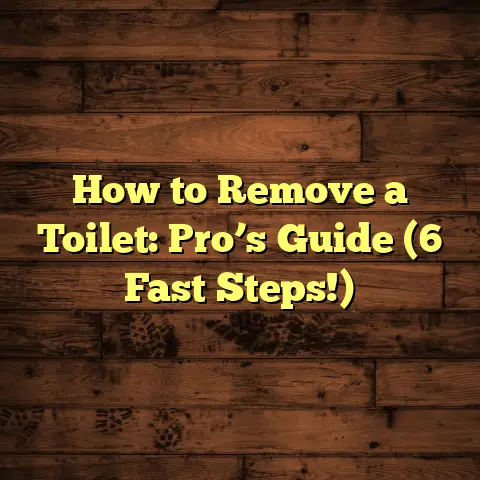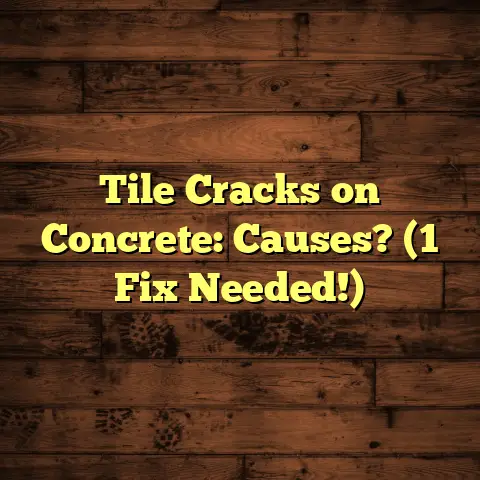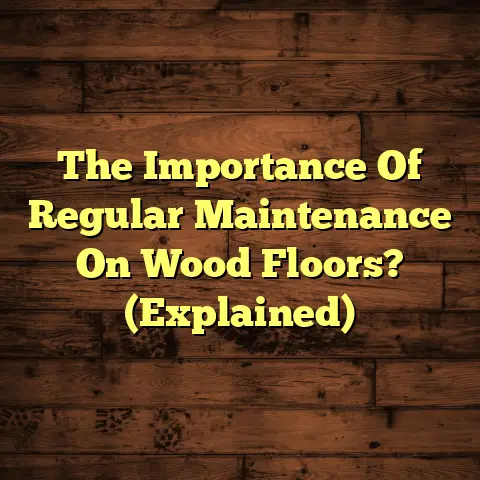Self Level Over Backer? (4 Crack Nightmares!)
Accessibility is key, right?
We all want
that gorgeous, smooth floor, and self-
leveling compounds seem like magic.
But trust me, it’s not always sunshine
and rainbows.
I’ve seen too many jobs go south because of improper prep and application, leading to cracks that are not only unsightly but also compromise the integrity of your entire flooring system.
Think about it: you’ve invested time,
money, and effort into your floors.
The
last thing you want is to see cracks
spider-webbing across your beautiful
new tile or luxury vinyl.
That’s where backer boards come in.
They’re your silent partners, providing
a stable foundation for that self-leveling
compound.
But even with backer boards,
things can go wrong.
In this article, I’m going to pull back the curtain and expose the four crack nightmares that can haunt your flooring dreams when using self-leveling compounds over backer board.
I’m talking about the real, nitty-gritty
issues I’ve seen on job sites, and how
you can avoid them.
Ready to dive in?
Section 1: Understanding Self-Leveling Compounds
So, what exactly are self-leveling compounds?
Simply put, they’re cementitious mixtures that, when mixed with water, flow easily to create a smooth, level surface.
Think of them as a liquid concrete that
finds its own level.
They’re typically
made up of:
- Cement: Provides the strength and binding properties.
- Aggregates: Fine particles like sand that add bulk and stability.
- Polymers: Enhance flexibility, adhesion, and water resistance.
- Additives: Control flow, set time, and other critical properties.
How do they work?
The magic lies in their fluidity.
You pour
the mixed compound onto the subfloor, and
it spreads out, filling in low spots and
creating a level plane.
Gravity is your friend here!
They’re incredibly useful when you’re dealing with uneven subfloors, like those in older homes or basements.
They’re also great for encapsulating radiant floor heating systems, creating a smooth surface for tile or other floor coverings.
Types of Self-Leveling Compounds
There’s more than one flavor of self-
leveling compound out there.
Here’s a
quick rundown:
- Cement-Based: The most common type, suitable for a wide range of applications.
- Gypsum-Based: Sets faster than cement-based, but less moisture-resistant. Best for interior, dry environments.
- Polymer-Modified: Enhanced with polymers for increased flexibility and adhesion. My go-to for challenging situations.
Important Note
Always, always follow the manufacturer’s
instructions!
Seriously, don’t wing it.
Mixing ratios, cure times, and application
techniques vary, and deviating can lead
to disaster.
I’ve seen guys try to “eyeball” the water
ratio and end up with a soupy mess that
never properly sets.
Section 2: The Role of Backer Boards
Okay, so we know what self-leveling
compounds are.
Now, let’s talk about
their trusty sidekick: the backer board.
What are backer boards?
Backer boards are rigid panels installed over the subfloor to create a stable, even surface for tile, stone, or other flooring materials.
They act as a bridge, spanning minor imperfections and providing a solid foundation.
Common Backer Board Materials
- Cement Board: My personal favorite
for wet areas like bathrooms and kitchens.
It’s incredibly durable and water-resistant.
Brands like HardieBacker and Durock are reliable choices. - Foam Board: Lightweight and easy to
cut, foam board provides insulation and
helps reduce sound transmission.
Good for situations where weight is a concern. - Plywood: While not technically a
backer board, plywood is often used as
a subfloor.
However, it’s crucial to ensure it’s the correct thickness and properly installed to prevent issues.
Backer Boards: Stability and Longevity
Backer boards play a crucial role in
preventing cracks and other flooring
problems.
They distribute weight evenly,
reducing stress on the subfloor and
preventing movement.
They also provide a stable base for the self-leveling compound to adhere to, ensuring a strong, long-lasting bond.
Proper Installation is Key
I can’t stress this enough: proper installation of backer boards is absolutely critical.
Here’s what you need to do:
- Stagger the seams: Just like with drywall, stagger the seams to prevent weak points.
- Use thin-set mortar: Apply a layer of thin-set mortar between the subfloor and the backer board to ensure a solid bond.
- Screw it down: Use backer board
screws to securely fasten the boards to
the subfloor.
Follow the manufacturer’s recommended screw spacing. - Tape the seams: Use fiberglass mesh tape and thin-set mortar to reinforce the seams and prevent cracking.
I once worked on a job where the installer skipped the thin-set mortar under the backer boards.
Big mistake!
The boards shifted over time,
causing the tile to crack and the whole
floor to fail.
Section 3: The Four Crack Nightmares
Alright, buckle up!
This is where we get
into the heart of the matter: the four
crack nightmares that can plague your
flooring project when using self-leveling
compound over backer board.
Nightmare 1: Shrinkage Cracks
What are they?
Shrinkage cracks occur when the self-
leveling compound dries and loses moisture.
As it dries, it shrinks, and if the
shrinkage is excessive, it can lead to
cracks.
Causes
- Rapid drying: If the compound dries too quickly, it can shrink unevenly and crack.
- High temperatures: High temperatures accelerate the drying process, increasing the risk of shrinkage cracks.
- Low humidity: Low humidity also promotes rapid drying.
- Improper mixing: Adding too much water to the mix can weaken the compound and make it more prone to shrinkage.
Environmental Factors
Temperature and humidity play a huge role
in shrinkage cracks.
Ideally, you want to
apply the self-leveling compound in a
temperature range of 60-80°F (15-27°C)
with moderate humidity.
Avoid applying it on hot, dry days or in direct sunlight.
Manifestation and Implications
Shrinkage cracks typically appear as fine, hairline cracks that run across the surface of the self-leveling compound.
They can weaken the bond between the compound and the backer board, leading to tile or flooring failure.
Nightmare 2: Expansion Cracks
What are they?
Expansion cracks occur when the self- leveling compound expands due to moisture absorption or temperature changes.
Causes
- Excessive moisture: If the compound is exposed to excessive moisture, it can expand and crack.
- Improper curing: Improper curing can prevent the compound from reaching its full strength and make it more susceptible to expansion.
- Temperature fluctuations: Significant temperature fluctuations can cause the compound to expand and contract, leading to cracks.
The Moisture Factor
Moisture is the enemy here.
Make sure the
backer board is dry before applying the
self-leveling compound.
Also, avoid applying the compound in areas that are prone to moisture, such as bathrooms or basements, without proper waterproofing.
Appearance and Functionality
Expansion cracks tend to be wider and more noticeable than shrinkage cracks.
They can affect the overall appearance of
the flooring and create uneven surfaces.
In severe cases, they can even cause the
flooring to buckle or lift.
Nightmare 3: Bond Failure Cracks
What is Bond Failure?
Bond failure occurs when the self-leveling compound fails to properly adhere to the backer board.
This can lead to cracks, delamination, and ultimately, flooring failure.
The Importance of Surface Prep
Surface preparation is absolutely critical in preventing bond failure.
Here’s what you need to do:
- Clean the backer board: Remove any
dust, dirt, debris, or loose particles
from the surface of the backer board.
I recommend vacuuming and then wiping down with a damp cloth. - Prime the surface: Apply a primer
specifically designed for use with self-
leveling compounds.
This will improve adhesion and prevent the compound from drying out too quickly. - Ensure compatibility: Make sure the
primer and self-leveling compound are
compatible.
Check the manufacturer’s recommendations.
Real-World Examples
I once saw a job where the installer
skipped the primer.
The self-leveling
compound dried out too quickly, creating
a weak bond with the backer board.
Within a few months, the tile started
cracking and popping up.
It was a
complete disaster!
Nightmare 4: Structural Movement Cracks
What are Structural Movement Cracks?
Structural movement cracks are caused by movement in the building’s foundation or structure.
These cracks can propagate through the subfloor and into the self-leveling compound and flooring.
Foundation Settling and Flooring
Foundation settling is a common cause of
structural movement cracks.
As the
foundation settles, it can put stress on
the subfloor, leading to cracks.
Early Signs
- Cracks in walls or ceilings: These can be an early warning sign of foundation problems.
- Doors or windows that stick: This can indicate that the building is shifting.
- Uneven floors: If your floors are noticeably uneven, it could be a sign of structural movement.
Impact on Flooring
Structural movement cracks can be difficult to repair and often require addressing the underlying structural issues.
They can cause significant damage to the flooring and compromise its integrity.
Section 4: Preventing and Addressing Crack Nightmares
Okay, so we’ve covered the crack
nightmares.
Now, let’s talk about how to
prevent them!
While the focus is on the issues, here’s a brief overview of preventive measures:
- Thorough Site Preparation: Clean, dry, and properly primed backer board is essential.
- Moisture Testing: Before you even think about pouring self-leveling compound, test the moisture levels in the subfloor and backer board.
- Acclimation of Materials: Allow the self-leveling compound and backer board to acclimate to the room’s temperature and humidity for several days before installation.
- Proper Mixing and Application: Follow
the manufacturer’s instructions to the
letter.
Don’t over-water the mix, and apply the compound evenly.
Conclusion
So, there you have it: the four crack nightmares that can haunt your flooring dreams when using self-leveling compounds over backer board.
Understanding these issues and taking preventive measures can save you a lot of headaches, time, and money.
Remember, a successful flooring project
starts with a solid foundation.
By
choosing the right materials, preparing
the site properly, and following best
practices, you can achieve a beautiful,
long-lasting floor that you’ll be proud
of for years to come.
Now, go forth and conquer your flooring
projects!
And remember, if you’re ever
unsure, don’t hesitate to call in a
professional.





